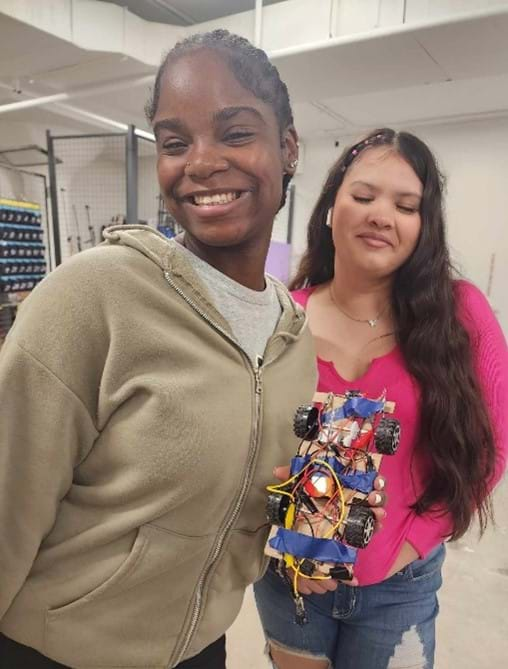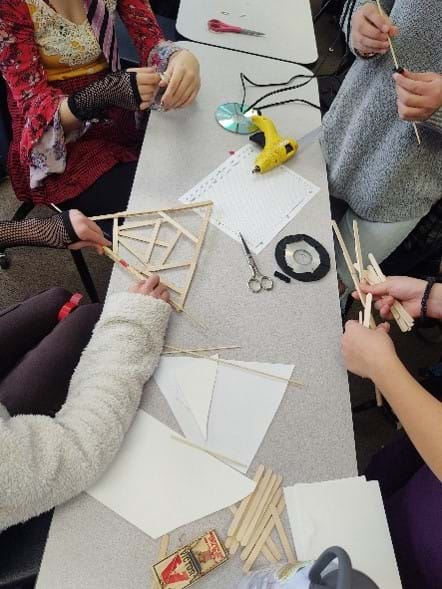
Summary
ASPIRE is an NSF-funded engineering research center focused on the future of widespread, affordable, and sustainable roadway electrification for all. The ASPIRE Creative Engineering Design unit is a project-based high school engineering curriculum that explores real-world engineering concepts and applications through the lens of electric vehicle (EV) technology. Through a range of hands-on activities, students build their knowledge and understanding of the connections between engineering and sustainable transportation, plus its challenges. Unit modules focus on the engineering design process (independent and team challenges), engineering skills development (introduction to CAD and electronics), and transportation-related environmental themes (air quality and public health). The summative assessment is a student-led team challenge to design-build-test-iterate a model EV.Engineering Connection
The ASPIRE Creative Engineering Design curriculum explores the intersection of electric vehicles (EV), the environment, and engineering. Numerous engineering fields take part in developing and building EVs. For example, Electrical, Mechanical, and Software Engineers work together to design and develop EV systems including electric motor and power electronics, chassis and suspension, and charging and battery management. Chemical Engineers contribute to designing and refining EV batteries to improve their performance, efficiency, and safety. Environmental Engineers engage in air quality management to address air pollution through developing air pollution control systems and strategies for sustainable practices.
Unit Overview
The ASPIRE Creative Engineering Design unit modules can be differentiated for introductory to advanced engineering classes.
Module 1 Introductory Rapid Design Challenges
Module 2 Engineering Design Process, Creative Crash Testing Design Challenge
Module 3 Environmental Impact StoryMaps, Mousetrap Car Design Challenge
Module 4 3D Design workshop, Carbon Footprint & Transportation Activity
Module 5 Circuits & EV Motor Workshop, Fuels Debate
Module 6 Electric Vehicle Design Challenge Summative Assessment

Subscribe
Get the inside scoop on all things TeachEngineering such as new site features, curriculum updates, video releases, and more by signing up for our newsletter!Unit Schedule
The ASPIRE Creative Engineering Design unit modules are organized in a suggested scope and sequence based on pilot teacher feedback. Each module is adaptable to fit any instructional time frame—quarter, semester, and year-long classes—and offers much flexibility to extend learning objectives to include related STEM content.
| Module | Topic | Learning Highlights |
|
1 |
Paper Tower Design Challenge | Students work as civil engineering teams in small groups to design and construct model towers out of paper with minimal teacher guidance on completing the challenge. |
| 1 | Efficient Car Design Challenge | Students learn how a car's aerodynamics and rolling resistance affect its energy efficiency by designing and constructing model cars out of simple materials. |
| 1 | Straw Bridges Design Challenge | Working as engineering teams, students use the engineering design process to plan, create, and test model bridges. |
| 2 | Engineering Design Process & Design Thinking | Students are formally introduced to the seven-step EDP using the various Engineering Design Process (EDP) steps in the previous design challenges. |
| 2 | Creative Crash Testing Design Challenge | Students utilize the full Engineering Design Process (EDP) as they become next-generation engineers working on the safety features for passenger vehicles. |
| 3 | Environmental Impact StoryMap Collection | The Environmental Impact StoryMap Collection actively engages students in exploring ethics-based, transportation-related topics. |
| 3 | Mousetrap Car Design Challenge | Students design, build, and test mousetrap cars as they apply the Engineering Design Process (EDP) in this individual engineering design challenge. |
| 4 | Tinkercad 3D Design & EV Dream Car Workshop | Students follow a guided engineering skills workshop presentation using the free online Tinkercad web app to design a model 3D EV concept car design. |
| 4 | Carbon Footprint & Transportation Activity | Students consider choices in transportation and calculate their carbon footprint to learn about their impacts and making informed choices. |
| 5 | Tinkercad Circuits & EV Motor Workshop | Students follow a guided engineering skills workshop presentation using the free online Tinkercad web app learning the basics about circuits, using a simulator to create circuits, and applying these skills to build a model EV electric motor. |
| 5 | Fuels Debate | Student teams learn about transportation fuels and then are assigned to represent the different fuels. Working cooperatively, the students develop arguments on the pros and cons of their fuel with the other fuel types. |
| 6 | Electric Vehicle Design Challenge | Students creatively collaborate in teams to design, build, test, and iterate a model electric vehicle (EV) car that runs on a battery-powered electric motor circuit. In a final design expo, teams have the opportunity to present their final EV model, their design process journey, and their perspectives on the intersection of engineering and environmental resiliency regarding EVs. Teams can also participate in fun model EV races and aesthetic design competitions. |
Assessment
The ASPIRE Creative Engineering Design summative assessment is the Electric Vehicle final design challenge, which engages student teams to design, build, test, and iterate a model EV. Teams work collaboratively to demonstrate their knowledge and understanding of the Engineering Design Process (EDP) to optimize the performance of their battery-powered model car. Students also apply their creative skills in designing an aesthetic EV, as well as a functional one. The culmination of the final assessment is the EV Design Expo where each team presents their model EV and reflects on the project process, including challenges they faced and how they addressed them, the successes and accomplishments they are proud of, future ideas or changes to further improve their model EV, and a key environmental aspect of EVs that resonated with the team. An assessment rubric and final project slide template is available to offer instructional guidance for teachers and a format for student teams to document their progress throughout the project.
Copyright
© 2025 by Regents of the University of Colorado BoulderSupporting Program
Integrated Teaching and Learning Program, College of Engineering, University of Colorado BoulderAcknowledgements
This curriculum was developed under National Science Foundation grant numbers 1941524 and 1941701. Any opinions, findings, and conclusions, or recommendations expressed in this material are those of the authors and do not necessarily reflect the views of the National Science Foundation.
Last modified: June 11, 2025



User Comments & Tips